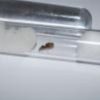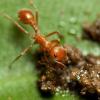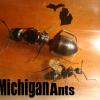Scientific Name: Lasius neoniger
Distribution: Widespread across the U.S. and Canada.
Queen size: 7-9mm
Worker size: 3-5 mm
Natural Habitat: They usually nest under rocks, in sand, but may also be found in rotting wood (including the timbers of houses), at the foot of trees, or in open ground.
Circadian Activity: Mostly nocturnal, but are active in the day as well.
Mating Flight: They fly anywhere from July to October depending on climate and location. The main flights usually occur in August or September. Has been known to fly on Labor day in September, earning it the nickname of the Labor Day Ant.
Queen Founding Method: The queen is Fully Claustral.
Monogyne or Polygyne: Generally Monogyne, sometimes temporary Polygyne groups can be found, but when the workers eclose they usually choose one queen and kill the rest.
Average time from egg to worker: Egg to Larvae = 15-18 days; Larvae to pupae = 10-15 days, Pupae to worker = 14-18 days. The colonies may grow fairly quickly, depending on the workers present and amount of food supplied.Egg to Larvae = 14 days; Larvae to pupae = 12-15 days, Pupae to worker = 12 days. They seem to grow very fast in the second year.
Recommended Temperature: 65-75F (18-24C)
Recommended Humidity: They prefer a moister nest.
Preferred Foods: Meal worms, Honey water. Most sugary foods and insects are readily accepted. Species: http://www.formicult...ood-by-species/
Hibernation Details: In the wild temperatures below freezing are common, even up to -40C/F. In captivity it is advised to stay above the freezing point as we are unable to easily duplicate the slow cool down into freezing temperatures. Hibernation is recommended between 39F (4C) - 50F (10C).
Escape Barrier Methods: Fluon and talcum powder method work best.
Difficulty rating: Very easy to keep.
Bite and/or Sting rating: They are too small to inflict any pain.
Special Care or Interesting Notes: They are escape artists, make sure there are no tiny openings.
Additional Links:
https://www.antweb.o...s&name=neoniger
Description: Workers of this species are usually dark brown in color, and have relatively large eyes (at least 12 ommatidia in greatest diameter). The scape has several erect hairs, but the extensor surface of the anterior tibia has fewer than 6 erect hairs. The penultimate basal tooth is smaller than the 2 adjacent teeth, and may even be absent, leaving a gap between the other basal teeth.
Information submitted by AntsMAN
Edited by dspdrew, March 5 2022 - 7:17 PM.



























